Near Real-Time Monitoring of Significant Sea Wave Height through Microseism Recordings: Analysis of an Exceptional Sea Storm Event
Abstract
1. Introduction
2. Study Area and General Features of the Adrian Storm
3. Materials and Methods
3.1. Weather and Sea Data
3.2. Microseismic Data
- Instrumental correction (deconvolution).
- Signal resampling at a frequency of 2 Hz.
- Offset and linear trend removal.
- Signal windowing into 1 hr windows.
- Computation of the Fourier transform for each window.
- Spectrogram calculation.
4. Results
4.1. Microseism Analysis
4.2. Weather and Sea Data Analysis
5. Discussion
- the differences between Hs measured by the buoy and those obtained by microseism linearly increase when the wind velocity and the absolute values of pressure gradient increase;
- the increases in wind velocity and absolute values of pressure gradient produce an increase in Hs with a delay up to 5 h (Figure 8). Then, the most suitable correction parameters are estimated averaging six samples of wind velocity and absolute values of pressure gradient.
6. Conclusions
Author Contributions
Funding
Institutional Review Board Statement
Informed Consent Statement
Data Availability Statement
Acknowledgments
Conflicts of Interest
References
- Devis-Morales, A.; Montoya-Sánchez, R.A.; Bernal, G.; Osorio, A.F. Assessment of extreme wind and waves in the Colombian Caribbean Sea for offshore applications. Appl. Ocean Res. 2017, 69, 10–26. [Google Scholar] [CrossRef]
- Ardhuin, F.; Stopa, J.E.; Chapron, B.; Collard, F.; Husson, R.; Jensen, R.E.; Johannessen, J.; Mouche, A.; Passaro, M.; Quartly, G.D.; et al. Observing Sea States. Front. Mar. Sci. 2019, 6, 124. [Google Scholar] [CrossRef]
- Mentaschi, L.; Besio, G.; Cassola, F.; Mazzino, A. Performance evaluation of Wavewatch III in the Mediterranean Sea. Ocean Model. 2015, 90, 82–94. [Google Scholar] [CrossRef]
- O’Reilly, W.C.; Olfe, C.B.; Thomas, J.; Seymour, R.J.; Guza, R.T. The California coastal wave monitoring and prediction system. Coast. Eng. 2016, 116, 118–132. [Google Scholar] [CrossRef]
- He, Y.; Shen, H.; Perrie, W. Remote Sensing of Ocean Waves by Polarimetric SAR. J. Atmos. Ocean. Tech. 2006, 23, 1768–1773. [Google Scholar] [CrossRef]
- Yaakob, O.; Zainudin, N.; Samian, Y.; Maimun, A.; Malik, A.; Palaraman, R.A. Presentation and validation of remote sensing ocean wave data. IJRRAS 2010, 4, 373–379. [Google Scholar]
- Reale, F.; Dentale, F.; Pugliese Carratelli, E.; Fenoglio-Marc, L. Influence of sea state on sea surface height oscillation from Doppler altimeter measurements in the North Sea. Remote Sens. 2018, 10, 1100. [Google Scholar] [CrossRef]
- Ludeno, G.; Reale, F.; Raffa, F.; Centale, F.; Soldovieri, F.; Pugliese Carratelli, E.; Serafino, F. Integration between X-band radar and buoy sea state monitoring. Ocean Coast. Discuss. 2016, 1–16. [Google Scholar] [CrossRef]
- Cui, J.; Bachmayer, R.; de Young, B.; Huang, W. Ocean wave measurement using short-range K-band narrow beam continuous wave radar. Remote Sens. 2018, 10, 1242. [Google Scholar] [CrossRef]
- Bromirski, P.D.; Duennebier, F.K.; Stephen, R.A. Mid-ocean microseisms. Geochem. Geophy. Geosy. 2005, 6. [Google Scholar] [CrossRef]
- Stutzmann, E.; Schimmel, M.; Patau, G.; Maggi, A. Global climate imprint on seismic noise. Geochem. Geophy. Geosy. 2009, 101. [Google Scholar] [CrossRef]
- Ardhuin, F.; Gualtieri, L.; Stutzmann, E. How ocean waves rock the Earth: Two mechanisms explain microseisms with periods 3–300s. J. Geophys. Res. 2015, 42, 765–772. [Google Scholar] [CrossRef]
- Ferretti, G.; Zunino, A.; Scafidi, D.; Barani, S.; Spallarossa, D. On microseisms recorded near the Ligurian coast (Italy) and their relationship with sea wave height. Geophys. J. Int. 2013, 194, 524–533. [Google Scholar] [CrossRef]
- Ferretti, G.; Scafidi, D.; Cutroneo, L.; Gallino, S.; Capello, M. Applicability of an empirical law to predict significant sea-wave heights from microseisms along the Western Ligurian Coast (Italy). Continent. Shelf Res. 2016, 122, 36–42. [Google Scholar] [CrossRef]
- Ferretti, G.; Barani, S.; Scafidi, D.; Capello, M.; Cutroneo, L.; Vagge, G.; Besio, G. Near real-time monitoring of significant sea wave height through microseism recordings: An application in the Ligurian Sea (Italy). Ocean Coast. Manag. 2018, 165, 185–194. [Google Scholar] [CrossRef]
- Ardhuin, F.; Stutzmann, E.; Schimmel, M.; Mangeney, A. Ocean wave sources of seismic noise. J. Geophys. Res. 2011, 116, C09004. [Google Scholar] [CrossRef]
- Davy, C.; Barruol, G.; Fontaine, F.R.; Sigloch, K.; Stutzmann, E. Tracking major storms from microseismic and hydroacoustic observations on the seafloor. Geophys. Res. Lett. 2014, 41, 8825–8831. [Google Scholar] [CrossRef]
- Donne, S.; Nicolau, M.; Bean, C.; O’Neil, M. Wave Height Quantification Using Land Based Seismic Data with Grammatical Evolution. 2014. Available online: http://ncra.ucd.ie/papers/cec2014_waves.pdf (accessed on 11 March 2021).
- University of Genoa. Regional Seismic Network of North-Western Italy; Other/Seismic Network; International Federation of Digital Seismograph Networks: Seattle, DC, USA, 1967. [Google Scholar] [CrossRef]
- Mentaschi, L.; Besio, G.; Cassola, F.; Mazzino, A. Implementation and validation of a wave hindcast/forecast model for the west Mediterranean. J. Coast. Res. 2013, 65, 1551–1556. [Google Scholar] [CrossRef]
- Chi, W.C.; Chen, W.J.; Kuo, B.Y.; Dolenc, D. Seismic monitoring of western Pacific typhoons. Mar. Geophys. Res. 2010, 31, 239–251. [Google Scholar] [CrossRef]
- Chen, X.; Tian, D.; Wen, L. Microseismic sources during Hurricane Sandy. J. Geophys. Res. Solid Earth 2015, 120, 6386–6403. [Google Scholar] [CrossRef]
- Davy, C.; Barruol, G.; Fontaine, F.R.; Cordier, E. Analyses of extreme swell events on La Réunion Island from microseismic noise. Geophys. J. Int. Oxf. Univ. Press (OUP) 2016, 207, 1767–1782. [Google Scholar] [CrossRef]
- Lin, J.; Lin, J.; Xu, M. Microseisms generated by super typhoon Megi in the western Pacific Ocean. J. Geophys. Res. Oceans 2017, 122. [Google Scholar] [CrossRef]
- Butler, R.; Aucan, J. Multisensor, microseismic observations of a hurricane transit near the ALOHA Cabled Observatory. J. Geophys. Res. Solid Earth 2018, 123, 3027–3046. [Google Scholar] [CrossRef]
- Xiao, H.; Xue, M.; Yang, T.; Liu, C.; Hua, Q.; Xia, S.; Huang, H.; Manh Le, B.; Yu, Y.; Huo, D.; et al. The characteristics of microseisms in South China Sea: Results from a combined data set of OBSs, broadband land seismic stations, and a global wave height model. J. Geophys. Res. Solid Earth 2018, 123, 3923–3942. [Google Scholar] [CrossRef]
- Pedemonte, L.; Corazza, M.; Forestieri, A.; Turato, B. Rapporto di Evento Meteorologico del 27-30/10/2018. Ligurian Environmental Protection Agency—Weather-Hydrological Functional Center of Civil Protection of the Liguria Region. 2019; p. 16. Available online: https://www.arpal.gov.it/contenuti_statici//pubblicazioni/rapporti_eventi/2018/REM_20181027-30_rossaBCDE_vers20190107.pdf (accessed on 11 March 2021).
- Casella, E.; Rovere, A.; Pedroncini, A.; Mucerino, L.; Casella, M.; Cusati, L.A.; Vacchi, M.; Ferrari, M.; Firpo, M. Study of wave runup using numerical models and low-altitude aerial photogrammetry: A tool for coastal management. Estuar. Coast. Shelf Sci. 2014, 149, 160–167. [Google Scholar] [CrossRef]
- Decreto del Commissario Delegato n. 2/2019. Eccezionali Eventi Meteorologici che Hanno Interessato il Territorio Della Regione Liguria nei Giorni 29 e 30 Ottobre 2018—OCDPC n.558/2018. Approvazione Elenco Comuni Danneggiati. Available online: https://www.regione.liguria.it/components/com_publiccompetitions/includes/download.php?id=32935:cdc-558-2-2019.pdf (accessed on 18 January 2021).
- Corradi, N.; Zaquini, M.; Ferretti, O. Interpretazione Sismostratigrafica Della Piattaforma Costiera Antistante la Foce Dell’Entella. ENEA “Il Golfo del Tigullio—Liguria Orientale. Avanzamento Degli Studi per la Creazione di Strumenti Della Gestione Costiera”. 2003. Available online: http://www.santateresa.enea.it/wwwste/dincost/dincost_pdf/7sismica.pdf (accessed on 11 March 2021).
- Capello, M.; Cutroneo, L.; Ferretti, G.; Gallino, S.; Canepa, G. Changes in the physical characteristics of the water column at the mouth of a torrent during an extreme rainfall event. J. Hydrol. 2016, 541, 146–157. [Google Scholar] [CrossRef]
- De Leo, F.; Solari, S.; Besio, G. Extreme waves analysis based on atmospheric patterns classification: An application along the Italian coast. Nat. Hazards Earth Syst. Sci. Discuss. 2020, 20, 1233–1246. [Google Scholar] [CrossRef]
- Lionello, P.; Abrantes, F.; Congedi, L.; Dulac, F.; Gacic, M.; Gomis, D.; Goodess, C.; Hoff, H.; Kutiel, H.; Luterbacher, J.; et al. Introduction: Mediterranean climate—Background information. In The Climate of the Mediterranean Region; Lionello, P., Ed.; Elsevier: Oxford, UK, 2012. [Google Scholar]
- Pensieri, S.; Bozzano, R.; Schiano, M.E. Comparison between QuikSCAT and buoy wind data in the Ligurian Sea. J. Marine Syst. 2010, 81, 286–296. [Google Scholar] [CrossRef]
- Sartini, L.; Cassola, F.; Besio, G. Extreme waves seasonality analysis: An application in the Mediterranean Sea. J. Geophys. Res. Oceans 2015, 120, 6266–6288. [Google Scholar] [CrossRef]
- Gallino, S.; Benedetti, A.; Onorato, L. Wave watching. In Lo Spettacolo Delle Mareggiate in Liguria; Hoepli: Milano, Italy, 2016; p. 182. [Google Scholar]
- Orlandi, A.; Pasi, F.; Onorato, L.f.; Gallino, S. An observation and numerical case study of a flash sea storm over the Gulf of Genoa. Adv. Sci. Res. 2008, 2, 107–112. [Google Scholar] [CrossRef]
- Cavaleri, L.; Bajo, M.; Barbariol, F.; Bastianini, M.; Benetazzo, A.; Chiggiato, J.; Davolio, S.; Ferrarin, C.; Magnusson, L.; Papa, A.; et al. The October 29, 2018 storm in Northern Italy—An exceptional event and its modeling. Prog. Oceanogr. 2019, 178, 102–178. [Google Scholar] [CrossRef]
- Celano, M.; Costa, S.; Foraci, R. Rapporto dell’evento meteorologico dal 27 al 30 ottobre 2018. Servizio Idro-Meteo-Clima. 2018, p. 49. Available online: https://allertameteo.regione.emilia-romagna.it/documents/20181/437770/Evento+27-30+ottobre+2018/ab59ec27-27c2-4793-b6f9-b0a91ceef30e (accessed on 11 March 2021).
- Erofeeva, S.; Padman, L.; Howard, S.L. Tide Model Driver (TMD) Version 2.5, Toolbox for Matlab, GitHub. Available online: https://www.github.com/EarthAndSpaceResearch/TMD_Matlab_Toolbox_v2.5 (accessed on 18 January 2020).
- Feng, X.; Olabarrieta, M.; Valle-Levinson, A. Storm-induced semidiurnal perturbations to surges on the US Eastern Seaboard. Cont. Shelf Res. 2016, 114, 54–71. [Google Scholar] [CrossRef]
- Zuur, A.F.; Ieno, E.N.; Smith, G.M. Analysing Ecological Data; Springer: New York, NY, USA, 2007. [Google Scholar]
- Cutroneo, L.; Castellano, M.; Carbone, C.; Consani, S.; Gaino, F.; Tucci, S.; Magrì, S.; Povero, P.; Bertolotto, R.M.; Canepa, G.; et al. Evaluation of the boundary condition influence on PAH concentrations in the water column during the sediment dredging of a port. Mar. Pollut. Bull. 2015, 101, 583–593. [Google Scholar] [CrossRef]
- Vousdoukas, M.I.; Voukouvalas, E.; Annunziato, A.; Giardino, A.; Feyen, L. Projections of extreme storm surge levels along Europe. Clim. Dyn. 2016, 47, 3171–3190. [Google Scholar] [CrossRef]
- Ullmann, A.; Pirazzoli, P.A. Recent evolution of extreme sea surge-related meteorological conditions and assessment of coastal flooding risk on the gulf of Lions. Méditerranée 2007, 108, 69–76. [Google Scholar] [CrossRef]
- Pasi, F.; Orlandi, A.; Onorato, L.F.; Gallino, S. A study of the 1 and 2 January 2010 sea-storm in the Ligurian Sea. Adv. Sci. Res. 2011, 6, 109–115. Available online: www.adv-sci-res.net/6/109/2011/ (accessed on 1 February 2021). [CrossRef]
- Bromirski, P.D.; Flick, R.E.; Graham, N. Ocean wave height determined from inland seismometer data: Implications for investigating wave climate changes in the NE Pacific. J. Geophys. Res. 1999, 104, 20753–20766. [Google Scholar] [CrossRef]
- Traer, J.; Gerstoft, P.; Bromirski, P.D.; Shearer, P.M. Microseisms and hum from ocean surface gravity waves. J. Geophis. Res. 2012, 117, B11307. [Google Scholar] [CrossRef]
- Ardhuin, F.; Balanche, A.; Stutzmann, E.; Obrebski, M. From seismic noise to ocean wave parameters: General methods and validation. J. Geophys. Res. 2012, 117, C05002. [Google Scholar] [CrossRef]
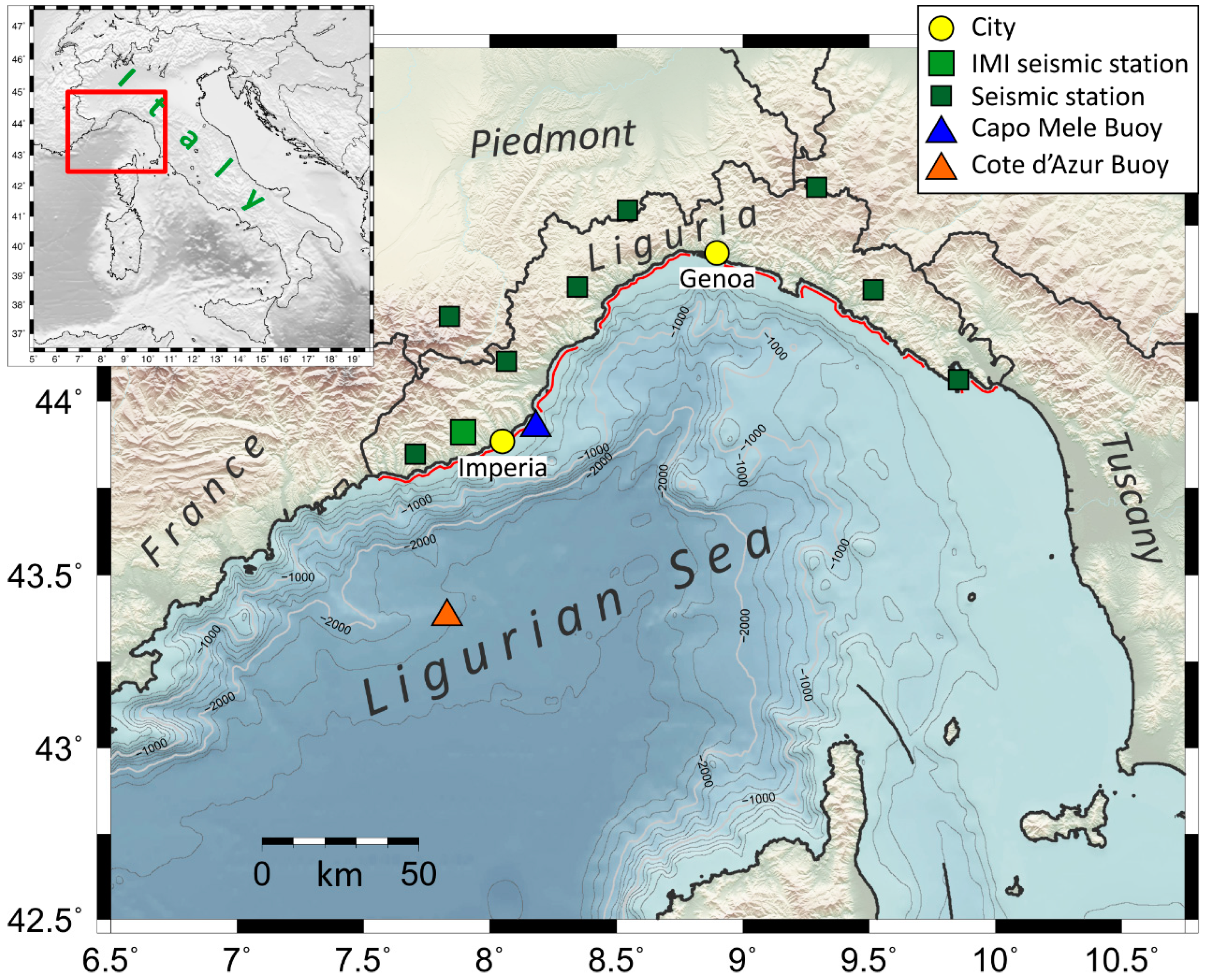
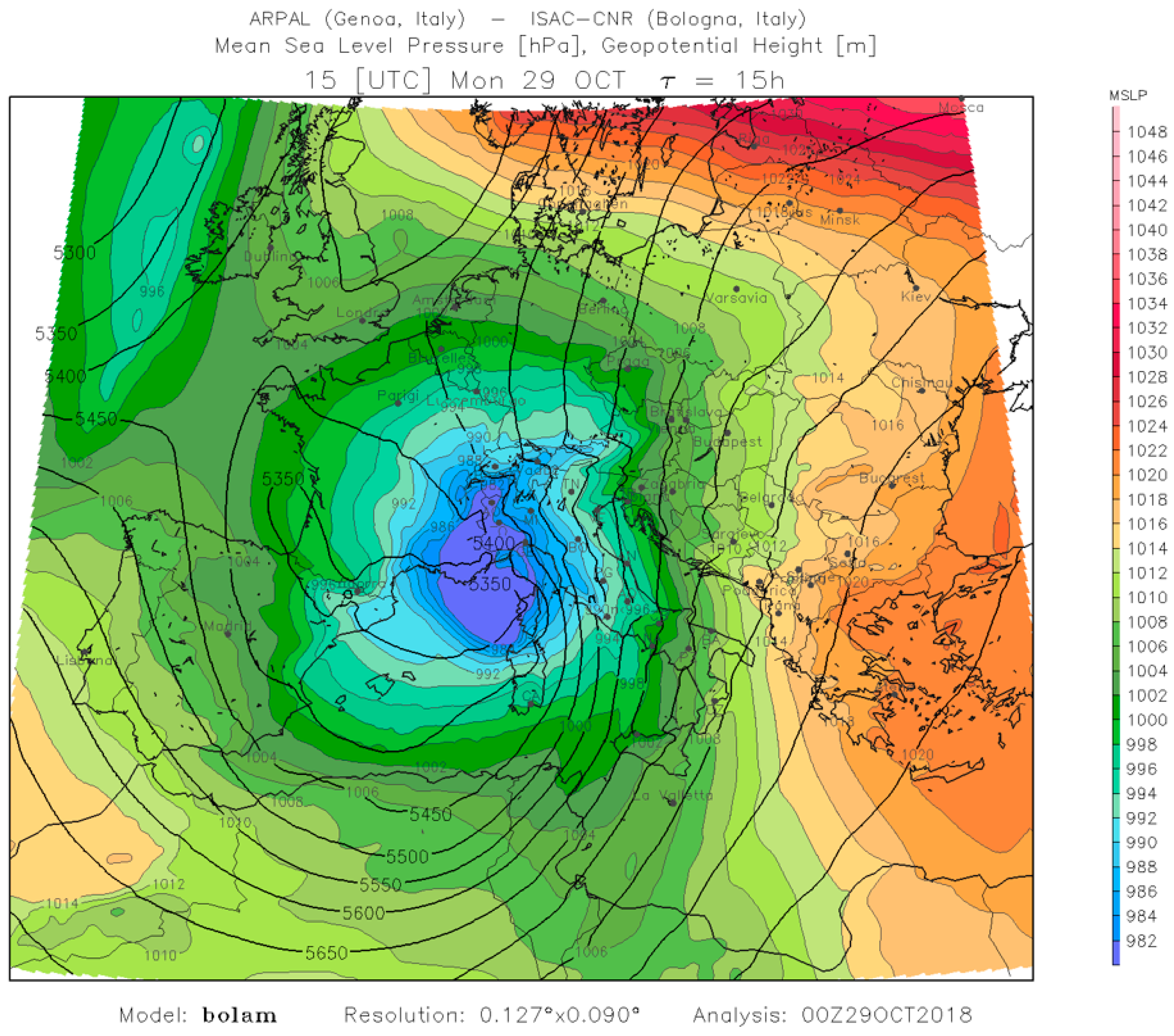
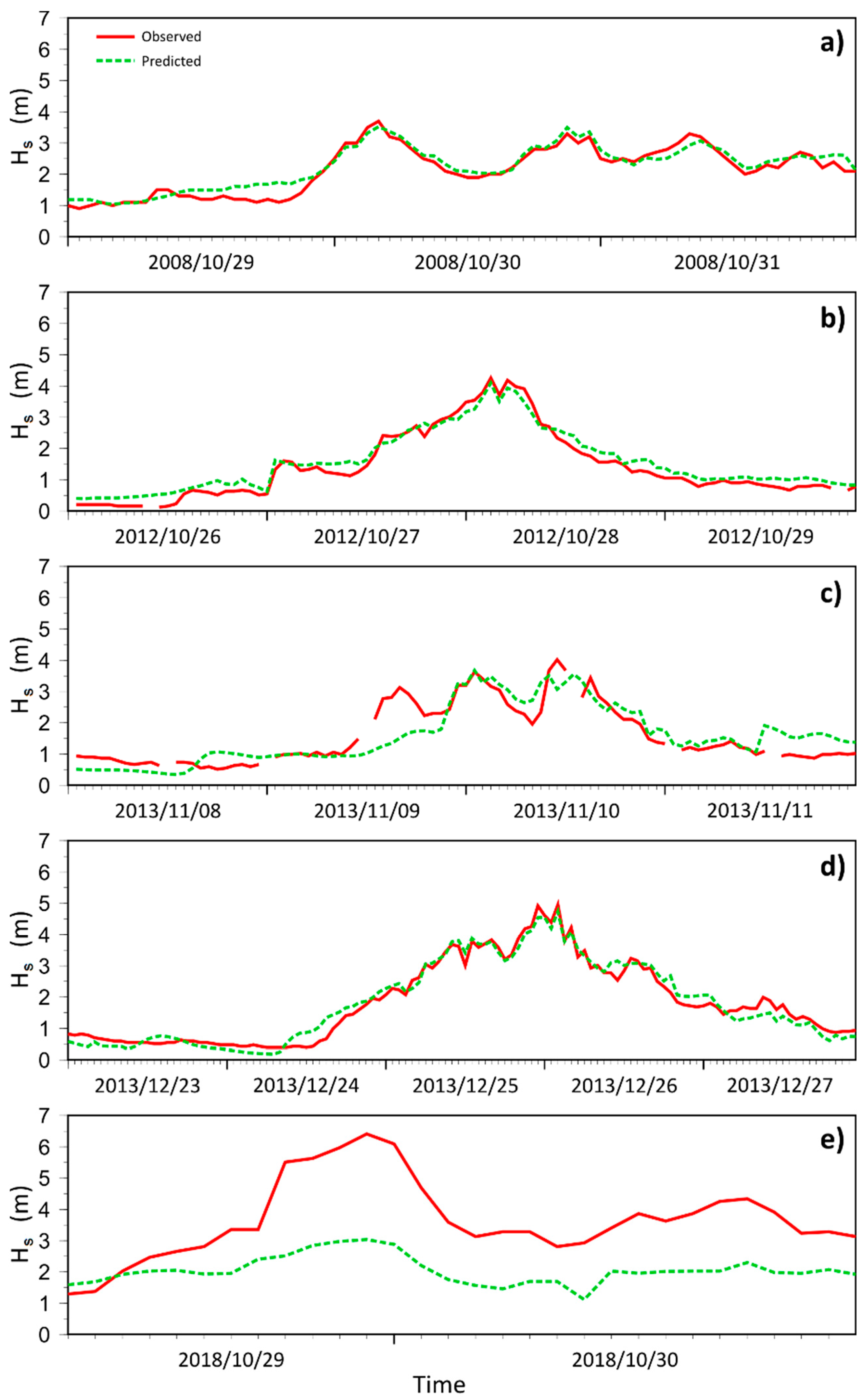
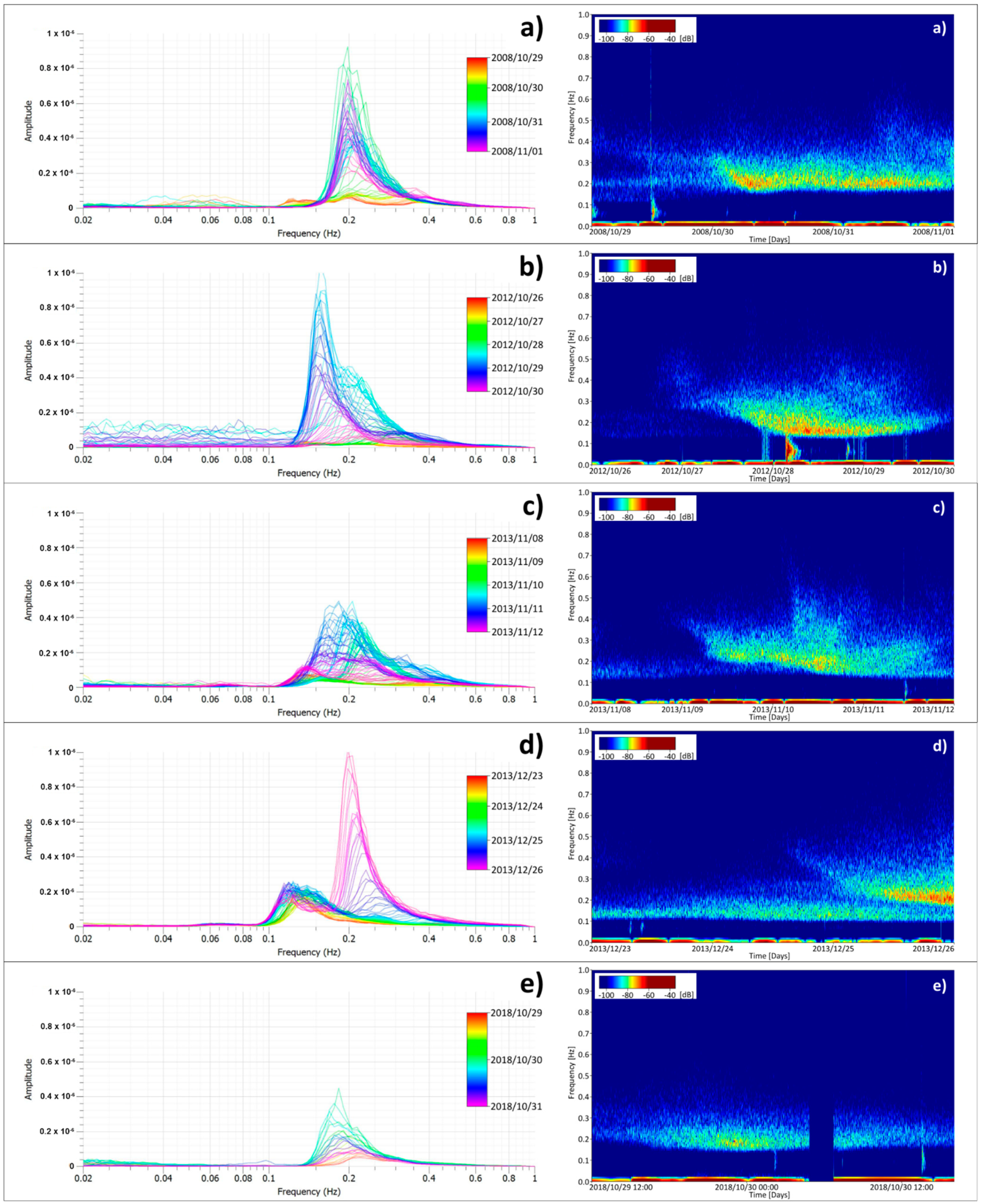
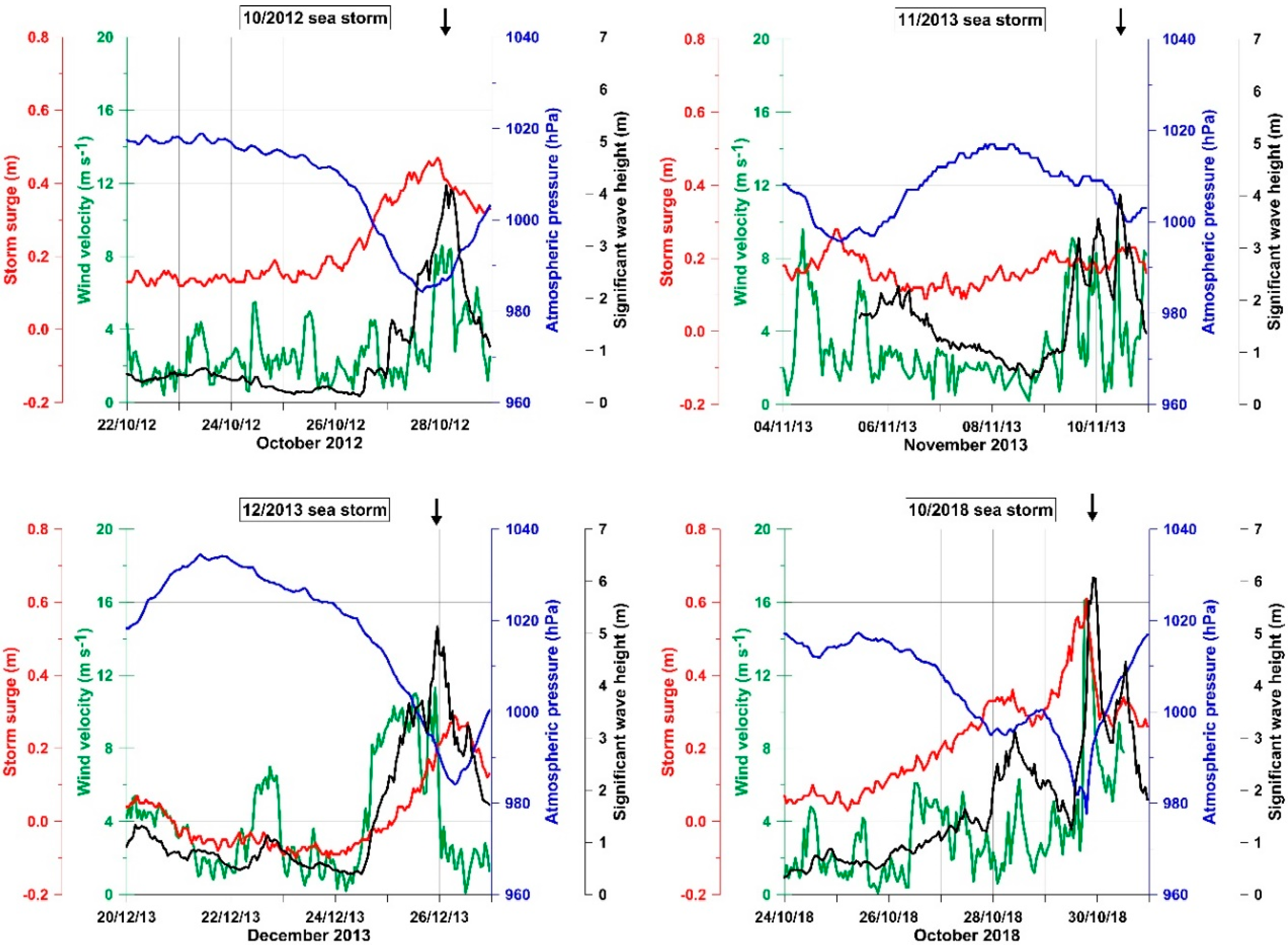
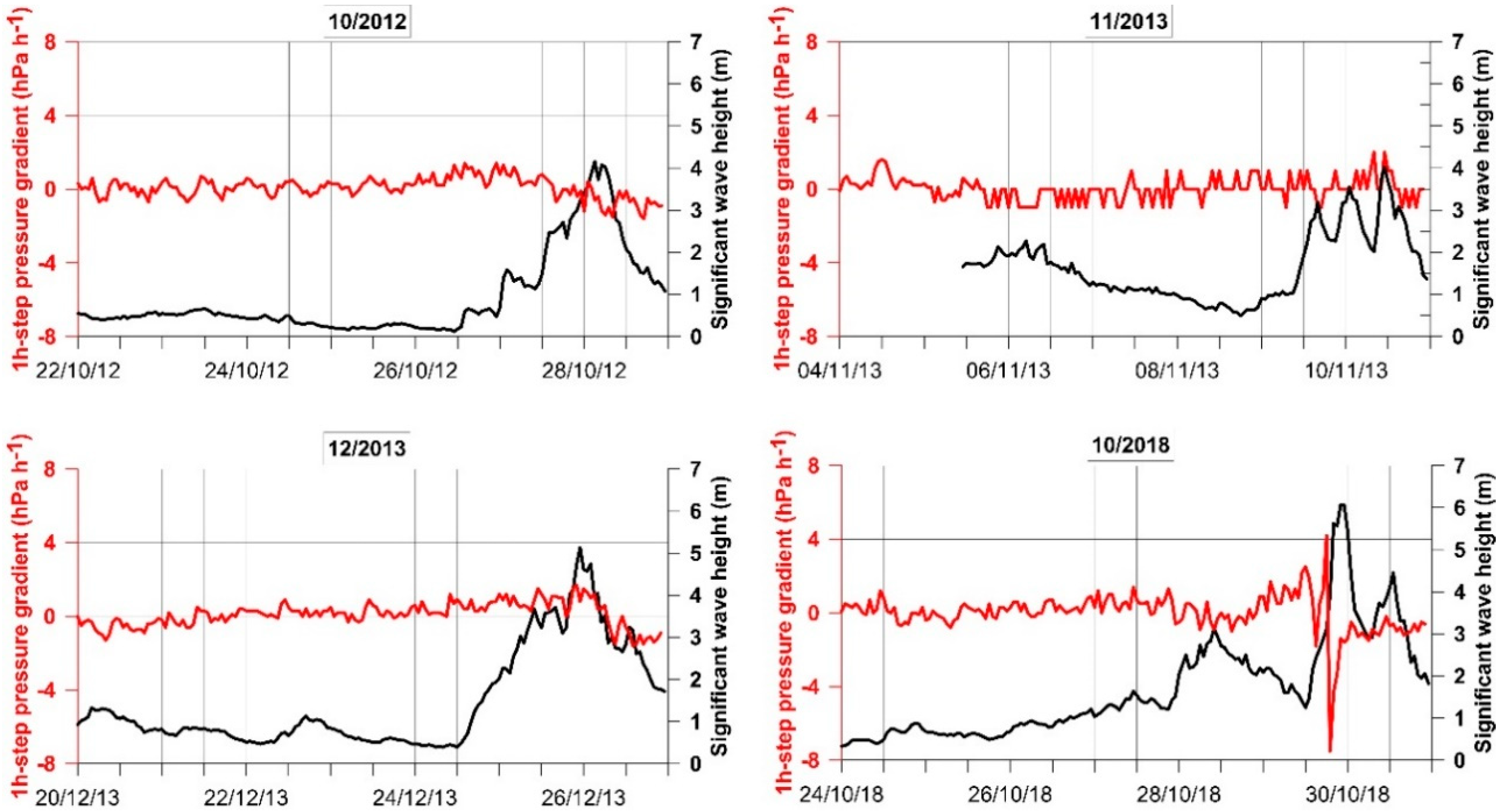
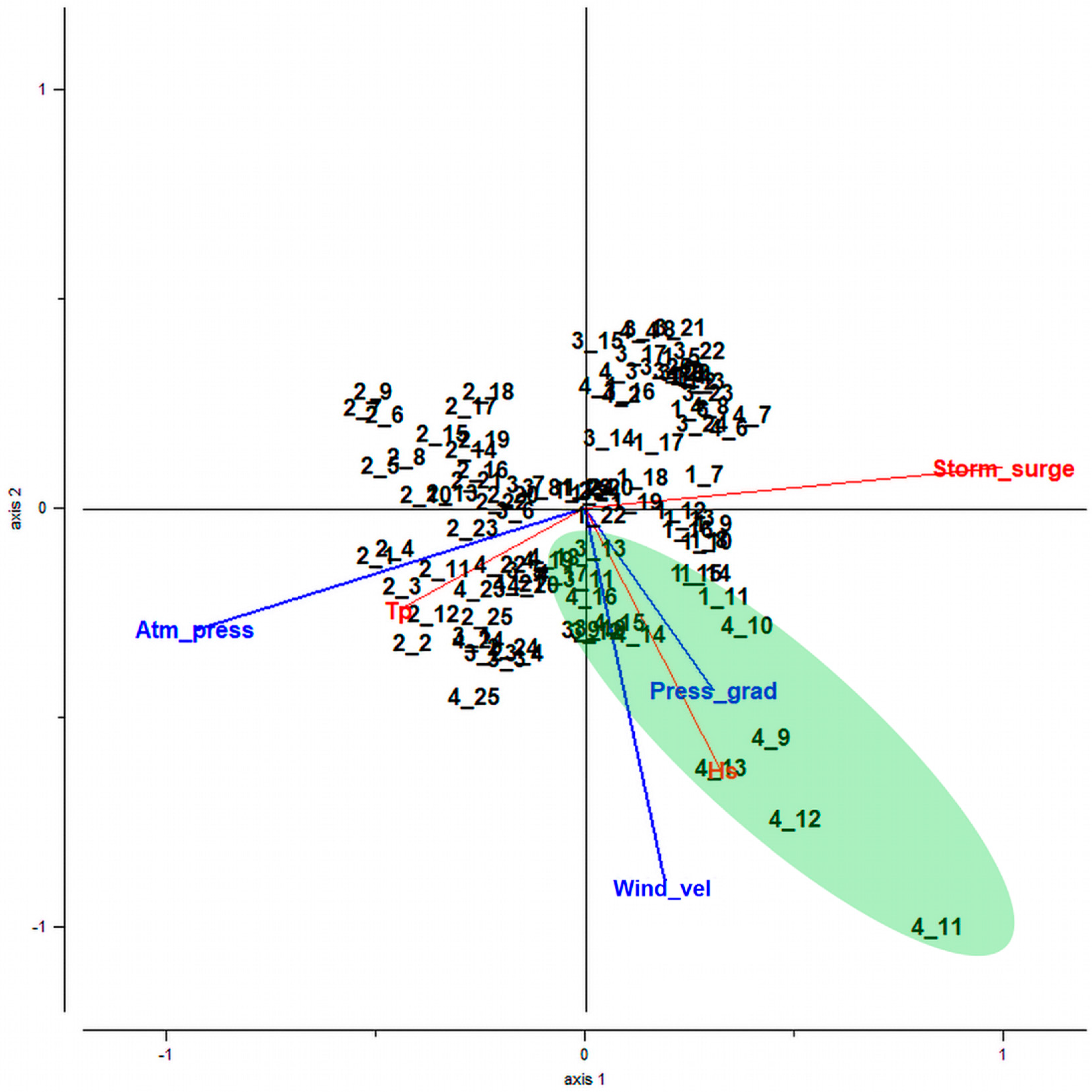

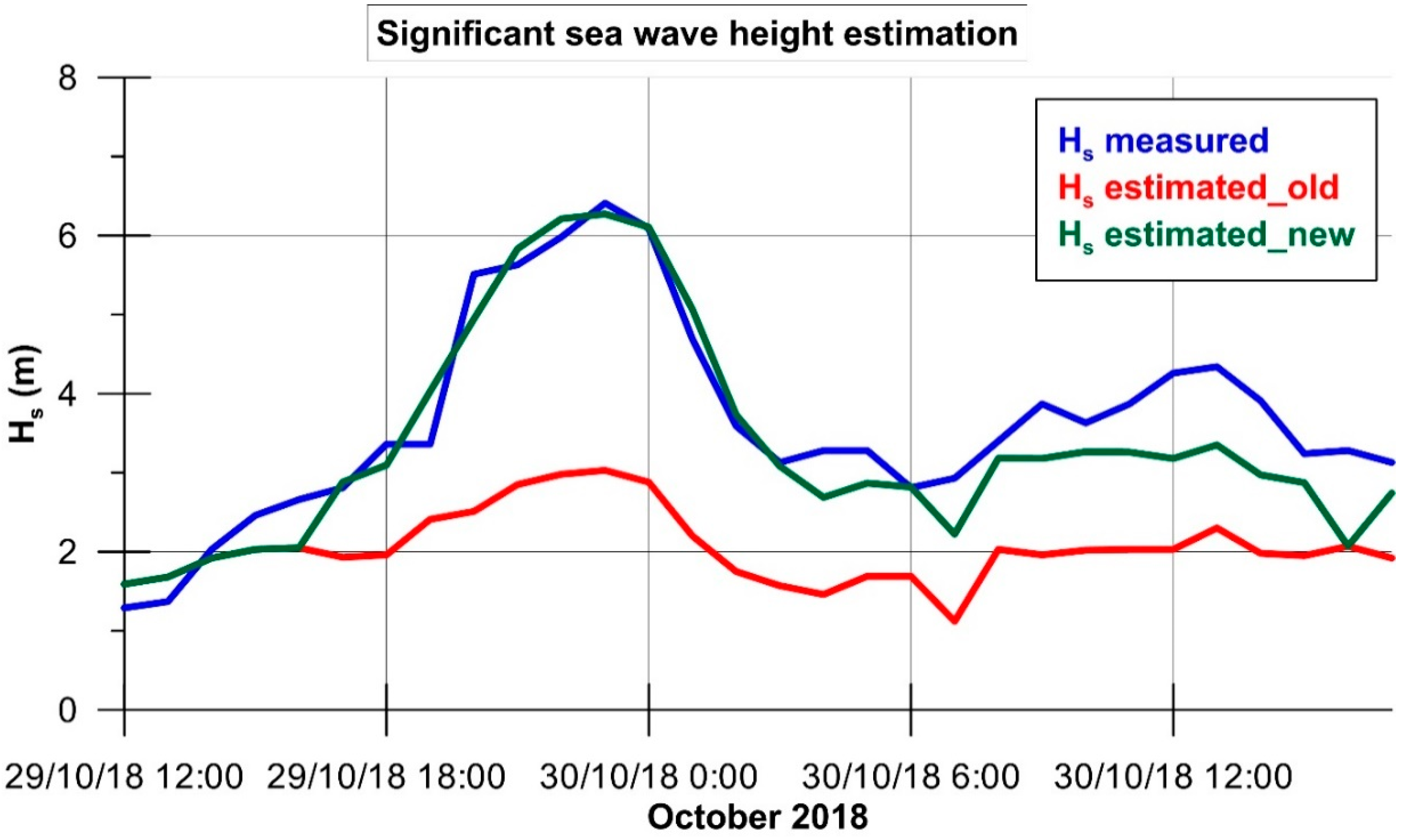
| Sea Storm | Sea storm Peak (dd/mm/yyyy hh:mm) | Period Considered for Weather Condition Evaluation (dd/mm/yyyy hh:mm) | Maximum Sea Wave Height (Hmax, m) | Maximum Significant Sea Wave Height (Hs, m) | Peak Sea Wave Period (Tp, s) | Mean Wave Direction during the Sea Storm Peak (° N) | Maximum Storm Surge (m) | Minimum Atmospheric Pressure (hPa) | Maximum of Mean Wind Velocity (m s−1) | Estimated Distance between the Capo Mele Buoy and the Minimum of Atmospheric Pressure (km) at the Maximum Hs Moment |
|---|---|---|---|---|---|---|---|---|---|---|
| October 2008 | 30/10/2008 n.a. | 26/10/2008 00:00–31/10/2008 23:30 | n.a. | 3.7 1 | n.a. | n.a. | n.a. | n.a. | n.a. | 22 |
| October 2012 | 28/10/2012 03:00 | 22/10/2012 00:00–28/10/2012 23:30 | 6.37 | 4.16 | 9.97 | 216 | 0.47 | 984.3 | 8.6 | 88 |
| November 2013 | 10/11/2013 11:00 | 05/11/2013 11:00 2–10/11/2013 23:30 | 6.02 | 4.02 | 9.67 | 340 | 0.23 | 1000 | 9.7 | 25 |
| December 2013 | 25/12/2013 23:00 | 20/12/2013 00:00–26/12/2013 23:30 | 8.40 | 5.14 | 10.5 | 185 | 0.29 | 984.4 | 11.3 | 105 |
| October 2018 | 29/10/2018 22:00 | 24/10/2018 00:00–30/10/2018 23:30 | 9.61 | 6.08 | 11.7 | 246 | 0.61 | 977.7 | 16.1 | 25 |
Publisher’s Note: MDPI stays neutral with regard to jurisdictional claims in published maps and institutional affiliations. |
© 2021 by the authors. Licensee MDPI, Basel, Switzerland. This article is an open access article distributed under the terms and conditions of the Creative Commons Attribution (CC BY) license (http://creativecommons.org/licenses/by/4.0/).
Share and Cite
Cutroneo, L.; Ferretti, G.; Barani, S.; Scafidi, D.; De Leo, F.; Besio, G.; Capello, M. Near Real-Time Monitoring of Significant Sea Wave Height through Microseism Recordings: Analysis of an Exceptional Sea Storm Event. J. Mar. Sci. Eng. 2021, 9, 319. https://doi.org/10.3390/jmse9030319
Cutroneo L, Ferretti G, Barani S, Scafidi D, De Leo F, Besio G, Capello M. Near Real-Time Monitoring of Significant Sea Wave Height through Microseism Recordings: Analysis of an Exceptional Sea Storm Event. Journal of Marine Science and Engineering. 2021; 9(3):319. https://doi.org/10.3390/jmse9030319
Chicago/Turabian StyleCutroneo, Laura, Gabriele Ferretti, Simone Barani, Davide Scafidi, Francesco De Leo, Giovanni Besio, and Marco Capello. 2021. "Near Real-Time Monitoring of Significant Sea Wave Height through Microseism Recordings: Analysis of an Exceptional Sea Storm Event" Journal of Marine Science and Engineering 9, no. 3: 319. https://doi.org/10.3390/jmse9030319
APA StyleCutroneo, L., Ferretti, G., Barani, S., Scafidi, D., De Leo, F., Besio, G., & Capello, M. (2021). Near Real-Time Monitoring of Significant Sea Wave Height through Microseism Recordings: Analysis of an Exceptional Sea Storm Event. Journal of Marine Science and Engineering, 9(3), 319. https://doi.org/10.3390/jmse9030319








